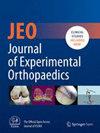This study aimed to compare the effects of four sterilization techniques on meniscal allograft transplantation (MAT) in rabbits.
In total, 85 medial or lateral meniscuses were obtained from 22 adult New Zealand white rabbits. These 85 meniscal allografts were seeded with Staphylococcus aureus (S. aureus) and randomly divided into five groups (n = 17): iodine group, Cobalt-60 group, glutaraldehyde group, ethylene oxide group and control group. Bacterial colonies of the allografts were determined before (n = 7) and after (n = 7) sterilization. Histological features were analyzed using haematoxylin and eosin (H&E) staining (n = 3). An additional 50 medial or lateral meniscuses were taken from 13 adult New Zealand white rabbits, and they were kept fresh-frozen (−40°C) for 1 month. Subsequently, these 50 meniscuses were randomly divided into five groups, which were treated with iodine, Cobalt-60, glutaraldehyde, ethylene oxide and normal saline, separately (n = 10), and stored at −20°C before MAT. MAT was given to the knee joints of the right hind legs of 50 adult Japanese white rabbits. After 6 weeks of MAT, the transplanted meniscal allografts were taken for biomechanical test (n = 7) and H&E staining (n = 3).
The results of the bacterial count indicated that the number of S. aureus colonies was less than 1 colony-forming unit (CFU)/allograft in all five groups after sterilization, except for the control group (415 CFU/allograft). H&E staining revealed that allografts in the iodine group presented the complete structure; allografts in the Cobalt-60 and glutaraldehyde groups were preserved relatively well; and allografts in the control and ethylene oxide groups were severely destructed, especially in the ethylene oxide group. Using the transplanted allografts, the biomechanical test showed that the maximum load of allografts in each group was significantly different, with ethylene oxide effective sterilization agents being used for disinfecting meniscal grafts (iodine group: 270.71 ± 62.81 N, Cobalt-60 group: 182.14 ± 71.29 N, glutaraldehyde group: 254.29 ± 31.55 N, ethylene oxide group: 40.00 ± 22.73 N and control group: 183.14 ± 76.40) (p ≤ 0.001). H&E staining with transplanted allografts revealed that allografts in the iodine group had the most intact structure; allografts in the Cobalt-60 and glutaraldehyde groups presented a relatively intact structure; and allografts in the control and ethylene oxide groups were seriously damaged, especially in the ethylene oxide group.
It was found that iodine, Cobalt-60, glutaraldehyde and ethylene oxide are effective sterilization agents for disinfecting meniscal grafts. Iodine exhibited superior preservation of both the biomechanics and structural integrity of the meniscal allografts, whereas ethylene oxide caused the most severe destruction to the meniscal allografts.
Not applicable because this is an animal study.



